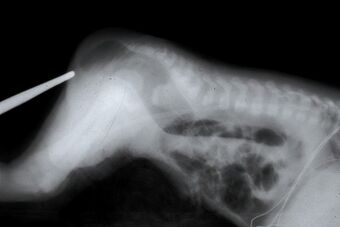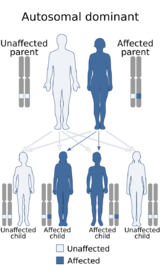Medicine:Currarino syndrome
| Currarino syndrome | |
|---|---|
| Other names | Currarino triad |
 | |
| An X-ray showing Imperforate anus | |
Currarino syndrome is an inherited congenital disorder where either the sacrum (the fused vertebrae forming the back of the pelvis) is not formed properly, or there is a mass in the presacral space in front of the sacrum, and there are malformations of the anus or rectum. It occurs in approximately 1 in 100,000 people.[1]
Anterior sacral meningocele is the most common presacral mass in patients with Currarino syndrome, occurring in 60% of cases. Its presence may significantly affect the surgical management of these patients.[2][3] Other potential presacral masses include presacral teratoma and enteric cyst. Presacral teratoma usually is considered to be a variant of sacrococcygeal teratoma. However, the presacral teratoma that is characteristic of the Currarino syndrome may be a distinct kind.[4]
Genetics

The disorder is an autosomal dominant genetic trait[5] caused by a mutation in the HLXB9 homeobox gene. In 2000 the first large series of Currarino cases was genetically screened for HLXB9 mutations, and it was shown that the gene is specifically causative for the syndrome, but not for other forms of sacral agenesis. The study was published in the American Journal of Human Genetics.[6]
Diagnosis
Diagnosis of Currarino syndrome is usually clinical, detecting all three elements of the triad. However, genetic testing is often used as the confirmation of diagnosis and genetic analysis of patient's family members.[7][8]
Treatment
Surgery of an anterior myelomeningocele is only indicated in the rare case in which the space-occupying aspect is expected to cause constipation or problems during pregnancy or delivery. Fistulas between the spinal canal and colon have to be operated on directly.[9]
Early diagnosis and multidisciplinary assessment is recommended to plan adequate treatment.[10]
By accurate evaluation, the correct surgical management, including neurosurgery, can be performed in a single-stage approach.[11]
The management of Currarino syndrome is similar to the usual management of anorectal malformation (ARM) regarding the surgical approach and probably the prognosis, which mainly depends on degree of associated sacral dysplasia.[12]
Neurosurgeons are involved in the surgical treatment of anterior meningoceles, which are often associated with this condition. The accepted surgical treatment is an anterior or posterior or a staged anterior-posterior resection of the presacral mass and obliteration of the anterior meningocele.[citation needed]
Posterior approach
A posterior procedure via lumbar and sacral partial laminectomy-laminoplasty and transdural ligation of the neck of the meningocele is used for anterior sacral meningoceles; alternatively, tumor excision is used for other types of presacral lesions.[citation needed]
Endoscopic or endoscope-assisted surgery via a posterior sacral route can be feasible for treatment of some patients with anterior sacral meningocele. Anterior meningocele pouch associated with Currarino syndrome will regresses over time following transdural ligation of its neck.[citation needed]
See also
References
- ↑ Weber, Stefanie; Dávila, Magdalena (2014). "German approach of coding rare diseases with ICD-10-GM and Orpha numbers in routine settings". Orphanet Journal of Rare Diseases 9 (Suppl 1): O10. doi:10.1186/1750-1172-9-s1-o10. ISSN 1750-1172.
- ↑ Emans, Pieter J.; van Aalst, Jasper; van Heurn, Ernest L.W.; Marcelis, Carlo; Kootstra, Gauke; Beets-Tan, Regina G.H.; Vles, Johannes S.H.; Beuls, Emile A.M. (2006-05-01). "The Currarino Triad: Neurosurgical Considerations". Neurosurgery 58 (5): 924–929. doi:10.1227/01.neu.0000209945.87233.6a. ISSN 0148-396X. PMID 16639328.
- ↑ Samuel, M.; Hosie, G.; Holmes, K. (December 2000). "Currarino triad—Diagnostic dilemma and a combined surgical approach". Journal of Pediatric Surgery 35 (12): 1790–1794. doi:10.1053/jpsu.2000.19258. ISSN 0022-3468. PMID 11101738.
- ↑ "Hereditary sacrococcygeal teratoma--not the same as its sporadic counterpart!". Eur J Pediatr Surg 17 (3): 214–6. June 2007. doi:10.1055/s-2007-965121. PMID 17638164.
- ↑ Ashcraft KW; Holder TM (October 1974). "Hereditary presacral teratoma". J. Pediatr. Surg. 9 (5): 691–7. doi:10.1016/0022-3468(74)90107-9. PMID 4418917.
- ↑ Belloni, E; Martucciello, G; Verderio, D; Ponti, E; Seri, M; Jasonni, V; Torre, M; Ferrari, M et al. (January 2000). "Involvement of the HLXB9 homeobox gene in Currarino syndrome.". American Journal of Human Genetics 66 (1): 312–9. doi:10.1086/302723. PMID 10631160.
- ↑ AbouZeid, Amr Abdelhamid; Mohammad, Shaimaa Abdelsattar; Abolfotoh, Mohammad; Radwan, Ahmed Bassiouny; Ismail, Mohamed Mohamed ElSayed; Hassan, Tarek Ahmed (August 2017). "The Currarino triad: What pediatric surgeons need to know" (in en). Journal of Pediatric Surgery 52 (8): 1260–1268. doi:10.1016/j.jpedsurg.2016.12.010. PMID 28065719.
- ↑ Garcia-Barceló, Mercè; So, Man-ting; Lau, Danny Ko-chun; Leon, Thomas Yuk-yu; Yuan, Zheng-wei; Cai, Wei-song; Lui, Vincent Chi-hang; Fu, Ming et al. (2006-01-01). "Population Differences in the Polyalanine Domain and 6 New Mutations in HLXB9 in Patients with Currarino Syndrome" (in en). Clinical Chemistry 52 (1): 46–52. doi:10.1373/clinchem.2005.056192. ISSN 0009-9147. PMID 16254195.
- ↑ Emans PJ, van Aalst J, van Heurn EL, Marcelis C, Kootstra G, Beets-Tan RG, Vles JS, Beuls EA (2006). "The Currarino triad: neurosurgical considerations". Neurosurgery 58 (5): 924–9; discussion 924–9. doi:10.1227/01.NEU.0000209945.87233.6A. PMID 16639328.
- ↑ Samuel M, Hosie G, Holmes K (Dec 2000). "Currarino triad--diagnostic dilemma and a combined surgical approach". J Pediatr Surg 35 (12): 1790–4. doi:10.1053/jpsu.2000.19258. PMID 11101738.
- ↑ Crétolle C, Zérah M, Jaubert F, Sarnacki S, Révillon Y, Lyonnet S, Nihoul-Fékété C (2006). "New clinical and therapeutic perspectives in Currarino syndrome (study of 29 cases)". J Pediatr Surg 41 (1): 126–31; discussion 126–31. doi:10.1016/j.jpedsurg.2005.10.053. PMID 16410121.
- ↑ AbouZeid AA, Mohammad SA, Abolfotoh M, Radwan AB, Ismail MME, Hassan TA (2017). "The Currarino triad: What pediatric surgeons need to know". J Pediatr Surg 52 (8): 1260–1268. doi:10.1016/j.jpedsurg.2016.12.010. PMID 28065719.
External links
| Classification | |
|---|---|
| External resources |
 |

